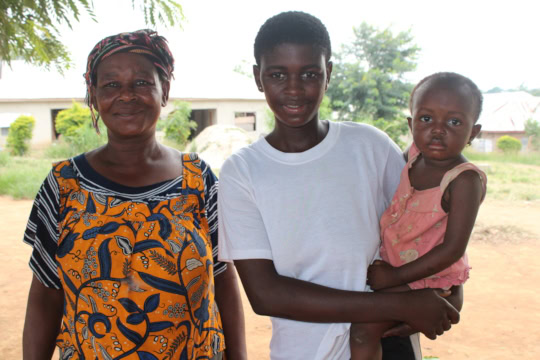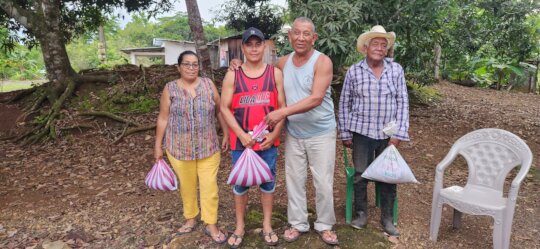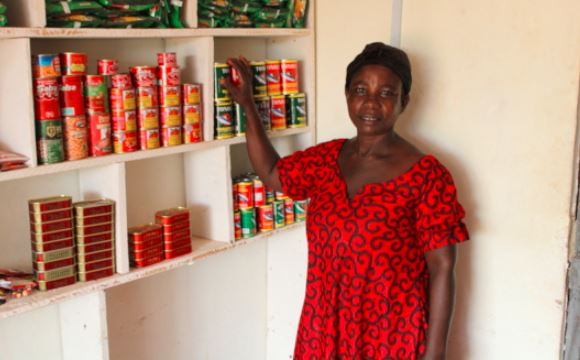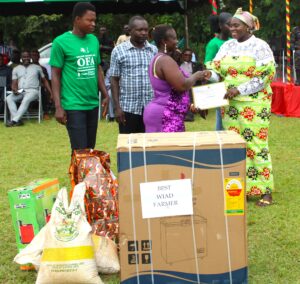Nicaraguan Farmers Astounded by Quality and Quantity of Maize Production
By Jorge Luis Campos Solis – Nicaragua Country Director

La Palma Farmers and SHI Staff Member, Jorge (in glasses)
Located in the middle of Lake Cocibolca (or Lake Nicaragua), Nicaragua, is the island of Ometepe. Ometepe Island is 106 square miles, has a population of approximately 29,000 inhabitants, and is known for its two volcanoes, Concepción and Maderas. It is classified as a Biospheric Reserve by the United Nations Educational, Scientific and Cultural Organization (UNESCO).

Bags of QPM seed.
In 2018 Self-Help International began working with farmers who are a part of Ometepe Island’s local organization, Flora and Fauna International Foundation, which focuses on diverse organic agricultural initiatives. The farmers seemed very pleased with the technical assistance of Self-Help International’s Agriculture Program. Self-Help staff trained and worked alongside 30 farmers from Moyogalpa and Altagracia, two of the northernmost communities on Ometepe Island. They planted 28 maize demonstration plots utilizing INTA-Nutrader seed and double-row planting technology. INTA-Nutrader seed is the Quality Protein Maize (QPM) seed being promoted by Self-Help in Nicaragua. The results were surprising, and the farmers on Ometepe Island wanted to talk about their experiences implementing the new farming practices they learned.
The La Palma Farmers

Margarito opening a bag of fertilizer.
The community of La Palma is 18 miles from the city of Altagracia on Ometepe Island. Travel along the lake coast to La Palma is difficult. The road is very rocky, and there is no cell phone service in the area. Despite its remoteness, a group of farmers from this community planted 400-square meter demonstration plots with INTA-Nutrader maize using the double-row technique and applying organic fertilizer.
Two findings emerged from the conversations with these farmers. First, the INTA-Nutrader variety of maize adapted well to the environment and climate. Second, the double-row planting method yielded more than the farmers were accustomed to producing using traditional seed and single row methods. Each of the farmers obtained from 400 and 450 pounds of maize from their plots, equivalent to 72 to 81 bushels per acre, and one farmer produced more than 500 pounds of maize, equivalent to 85 bushels per acre. Normal yields in the area with traditional seed and and technology are 16 to 25 bushels per acre.

Margarito showing his harvest to SHI Staff Members.
“I have good news: I obtained 450 pounds of maize from my plot,” La Palma farmer Eufemio Hernandez said. “I’m surprised by the yield of the double-row technique using only organic fertilizers and worm humus (manure produced by worms). Next year, I’m going to plant more and I’ll do even better.”
“I am satisfied with this variety of maize seed. Even though I wasn’t able to cultivate it very well, my plot still yielded 450 pounds of maize,” Margarito Velazquez, another La Palma farmer, said. “I want to show you all of the sacks of maize stacked up in my home right now so you can see it for yourself.”
“In the beginning I didn’t think this new seed and these new techniques would work; however, in the end, I’m satisfied with the 400 lb of maíze that I harvested,” José Antonio Menocal, another farmer, chimed in. “My whole family was surprised by this yield.”

Jose showing his QPM crop.
“I also used the new methods Jorge taught us when I planted my seed, but I really doubted the double-row technique and the new seed,” Honorio Hernandez said. “When I saw the maize beginning to grow and it reached as high as my knees, I realized that this maize variety is unstoppable.”
“I think I had the same experience as my associates – we’re going to continue trying this variety because it also has more protein and the yields are fantastic when it’s paired with the double-row planting technique,” Honorio added. “I am about to plant and invite other farmers to plant with this variety and technique. Thank you to the Self-Help International staff for teaching us about this seed and this technique. This is new for us.”
“La Finca” Agribusiness
Carlos Barrios and his wife own an agribusiness named “La Finca,” and they’ve been able to sell a total of 53 bags of INTA-Nutrader certified seed to farmers near Altagracia, Ometepe, thanks to the training that Self-Help staff provided.
“Many farmers liked the seed and came for more, planted it, and were pleased with the quality and price,” Carlos said. “Additionally, this is the first seed commercialization business on the island. I’m already planning ahead and have orders placed for next year. I look forward to cooperating with Self-Help International to distribute and market this new seed in Altagracia.”
Improved Ovens Introduced
Women business owners have also benefited from Self-Help’s work on Ometepe Island, after Self-Help staff taught the women about a new type of baking oven that burns wood more efficiently and protects them from inhaling as much smoke.

Martiza showing her new oven.
Martiza Paisano and Lilliam Velazquez are two women business owners using the improved ovens to make artisanal breads on the island. Self-Help facilitated the trainings and access to the barrels used to construct the ovens, through Flora and Fauna International. Maritza has been introducing her new oven to other women in her community so they can begin making artisan breads and learn how to use the new improved oven technology, as well.
Both men and women on Ometepe Island are sharing in the joy of bountiful yields and better ovens. Self-Help International is looking forward to continuing to support the farmers and business owners on Ometepe Island, to help them feed their communities, provide for their families, and manage their businesses.

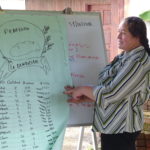 Next Post
Next Post